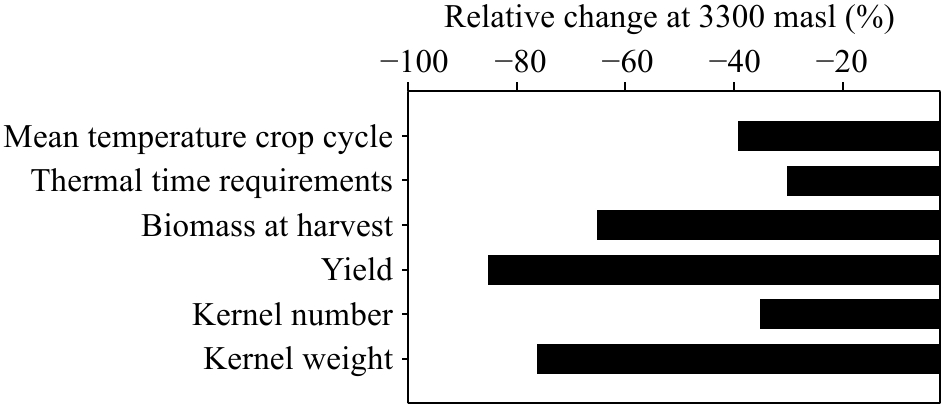-

Figure 1.
Maize plots in farmer's fields located at very high altitude environments (> 3,000 masl). Usually, the crop is fertilized with goat manure and irrigated by furrow throughout the growing season following weekly turns organized by the community. Weeds are manually controlled, and pest incidence is overall very low. Sowing is done manually leading to significant stand heterogeneity (a), and furrows are placed against the slope when appropriate (a, left). (b) Intercropping is also a usual practice. Geographical coordinates, altitude and date are indicated in the right corner of each image.
-

Figure 2.
Relative change for different factors or crop parameters measured at 3300 masl compared with 2300 masl during experiments carried out at two high altitude sites of Argentina: Hornillos (2,300 masl, Jujuy) and El Rosal (3,300 masl, Salta) during 2021−22 (calculated from absolute values in Salve et al.[9]).
-
Trait Location Latitude Altitudinal range Response to
increased altitudeReferences Phenology and canopy development Days to tasseling East-African countries 8°−(−13)° 352 vs 1913 Increase (+27 d) Darrah and Penny[37] Days to tasseling East-African countries 8°−(−13)° 1210 vs 1913 Increase (+27 d) Darrah[80] Crop cycle length Kenya 0−1° 1268 vs 2250 Increase (80 d) Cooper[13] Crop cycle length Mexico 19° 600 vs 2050 Increase (69 d) Pace[27] Crop cycle length Mexico 19−21° 60 vs 2650 Increase (58 d) Jiang et al.[8] Thermal time Kenya 0−1° 1268 vs 2250 Unchanged Cooper[13] Thermal time Mexico 19−21° 60 vs 2650 Decrease Jiang et al.[8] Final leaf number Kenya 0−1° 1268 vs 2250 Decrease (-2 leaves) Cooper[13] Final leaf number Mexico 19−21° 800 vs 2240 Decrease Lafitte & Edmeades[14] Final leaf number Mexico 19−21° 60 vs 2650 Increase (2,4 leaves) Jiang et al.[8] Leaf size Kenya 0−1° 1268 vs 2250 Increase, then decrease Cooper[13] Leaf size Mexico 19−21° 800 vs 2240 Increase, then decrease Lafitte & Edmeades[14] Canopy senescence Mexico 19−21° 800 vs 2240 Delayed Lafitte & Edmeades[14] Canopy senescence Southafrica (−29)° 420 vs 1620 Accelerated Wilson et al.[35] Biomass and yield Biomass Southafrica (−29)° 420 vs 1620 Unchanged Wilson et al.[35] Biomass Mexico 19−21° 800 vs 2240 Similar Lafitte & Edmeades[14] Biomass Mexico 19−21° 60 vs 2240 Increase (+ 147%) Jiang et al.[8] Yield Kenya 0° 1525 vs 2593 Unchanged Arkel[81] Yield East-African countries 8°−(−13)° 352 vs 1913 Increase (+ 60%) Darrah & Penny[37] Yield East-African countries 8°−(−13)° 1210 vs 1913 Increase (+ 18%) Darrah[80] Yield Kenya 0−1° 1268 vs 2250 Increase (+ 82%) Cooper[13] Yield Mexico 16° 1500 vs 2150 Increase (+ 300%) Mercer et al.[38] Yield Mexico 19−21° 60 vs 2240 Increase (+ 155%) Jiang et al.[8] Yield Mexico 19° 1850 vs 2400 Increase (+ 800%) Pace[27] Prolificy Kenya 0−1° 1268 vs 2250 Increase (+ 58%) Cooper[13] Grain number Mexico 19° 1850 vs 2400 Increase (+ 83%) Pace[27] Grain number Southafrica (−29)° 420 vs 1620 Unchanged Wilson et al.[35] Grain number Kenya 0−1° 1268 vs 2250 Increase (+ 48%) Cooper[13] 1000 grain weight (primary cob) Kenya 0−1° 1268 vs 2250 Increase (+ 25%) Cooper[13] 1000 grain weight Mexico 19° 1850 vs 2400 Increase (+ 64%) Pace[27] 1000 grain weight Mexico 19−21° 60 vs 2240 Increase (+ 9%) Jiang et al.[13] 1000 grain weight Mexico 19° 600 vs 2050 Increase (400%) Pace[27] Table 1.
Changes in different traits in response to increasing altitude based on available literature. When more than one season was available, average change across seasons is considered; when several adaptation groups were tested, the response of the highland-adapted group is reported (or the best-performing genotype). Relative values for the responses are approximate as most of the results are based on figures.
-
Group Representative races Cycle length Plant size Ear traits Endosperm Uses 'Capias' 'Capia' ('blanco'/ 'variegado'/ 'rosado'/ 'amarillo'/ 'marrón'), 'Cuzco', 'Chulpi' and 'Culli' Long Tall plants Big ears, 16−20 number of rows, large kernels, wide variety of colours Floury (dextrinous
in the Chulpi race)Typical food and drinks: 'Capias', 'Mote', 'Tamal', 'Tijtincha', Äpi'and 'Chicha morada' 'Cristalinos' 'Morocho', 'Calchachí', 'Cristalino Blanco', 'Cristalino Amarillo' (or 'chico'), and 'Amarillo de Ocho' (or 'grande'). Medium Medium plants Crystalline endosperm, yellow or white color Crystalline (flint) Typical food: 'Locro', 'Mazamorra', 'Humita' and 'Chicha' 'Reventadores' 'Pisingallo', 'Perlita' Short Medium plants Small kernels, pointed shape, popped Crystalline (flint) Pop-corn and typical food and drinks ('chilcan',
'ulpada' and 'miskopitapi').'Altiplano' 'Bola blanca' and 'altiplano' Short Small plants Small and round ears with small kernels. Irregular kernel row arrangement Floury or crystalline Grain or forrage Table 2.
Characterization of main maize races cropped in high altitude environments from the Northwest of Argentina based on races defined by Cámara Hernández et al.[47]. The criteria we followed for grouping races was based on the different traits indicated in columns.
-
GROUP Land tenure Water origin Water access Soil texture Soil erosion Maize purpose Fertilizer Years using seed Races sown anually Earliest sowing Earliest harvest 2,100-2,400 masl
(n = 14; avg = 2.2 has)










2,500-3,900 masl
(n = 9; avg = 1 ha)










Color references 
Owner River/ ditch Enough Sandy Severe Both Manure (own) < 10 years 1 or 2 Before October Before April 
Community Thaw Not enough Clay Moderate Self-consumption Manure (bought) between 10 and 20 3 or 4 October April 
Both No answer Silty No erossion Selling Both/ others > = 20 years > 4 After October After April Table 3.
Own results obtained from surveys to farmers carried out in 2021 as part of a FAO Project (detailed in the text). A total of 23 farmers were interviewed across an altitudinal gradient spanning from 2,100 to 3,900 masl; results were grouped into two groups according to altitude.
Figures
(2)
Tables
(3)